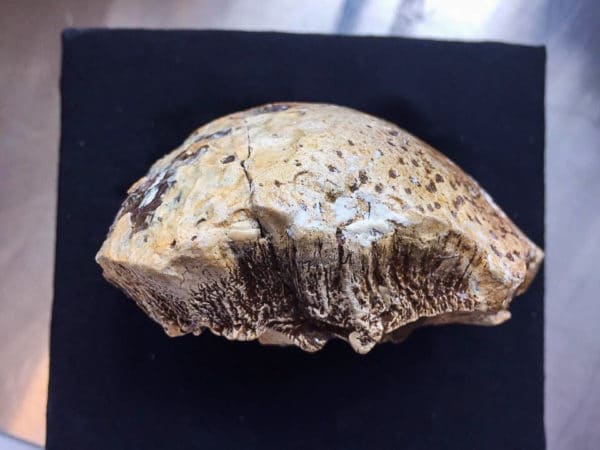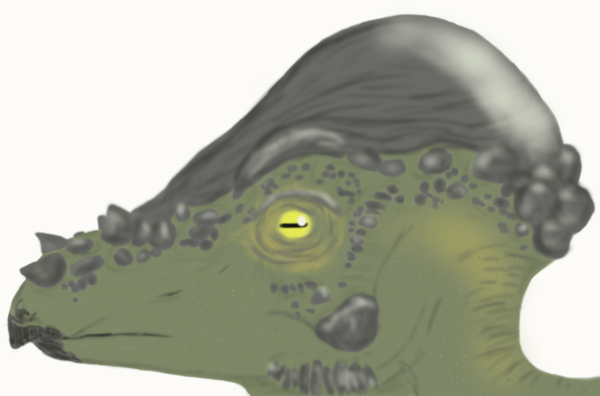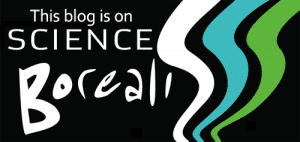
Everyone knows Pachycephalosaurus, that bipedal dome-head that ran around head-butting other dinosaurs all day long, but few people ever stop and give it much thought beyond that. The history and biology of Pachycephalosaurus and its relatives is complex, and for a family of dinosaurs that’s been a pop culture staple for so long we still don’t know a whole lot about the pachycephalosaur family.
This is an odd group of dinosaurs, with Pachycephalosaurus being the largest so far yet perhaps not the strangest. Like their basal ornithischian ancestors, pachycephalosaurs were bipedal, never attainting giant quadruped morphs like all other bird-hipped dinosaur lineages eventually did. There’s precious little post-cranial material from these already rare dinosaurs known, so for many species we can only infer what they looked like from the neck down by studying a few relatively complete specimens. The most common part of them to fossilize is their skulls, especially the gnarly spikes and dense, bony dome that crowned the heads of these animals. Not all species in this family had domed heads, mind you, as this feature gradually became more and more prominent throughout the evolution of the group. Pachycephalosaurs bore pretty small teeth with noticeable denticles or ‘serrations’ along their edge, and some could be fairly pointed, leading some palaeontologists to suspect this group may have been omnivorous. These denticle-bearing teeth have caused a fair degree of confusion for scientists over the decades, as we’ll explore later.
While you might think pachycephalosaurs were closely related to the hadrosaurs, being bipedal plant eaters, but their closest relatives are actually the horned ceratopsians. These two groups are united by a fringe at the back of the skull (which gives them their united name, Marginocephalia) which in ceratopsians formed the frill but in pachycephalosaurs remained as a smaller bony ridge. Definitive pachycephalosaur remains have so far only come from the late Cretaceous of North America and Asia, but since basal ceratopsians are known from the late Jurassic, this group must extend as far back to have split off from the horned dinosaurs at their origin.
The history of our knowledge of Pachycephalosaurus is closely tied into that of its smaller relative Stegoceras, as well as the troodontid family of theropods, oddly enough. In typical fashion for long-known American dinosaurs, the first remains known to science belonging to Pachycephalosaurus were fragmentary bits collected from end-Cretaceous rocks out west and sent to Joseph Leidy. He got his hands on a bit of rough, bumpy squamosal bone from the back of a Pachycephalosaurus skull (Baird, 1979) and, believing it to have come from the back of some sort of small, armored reptile, called it Tylosteus (Leidy, 1872).
A few decades later, somewhat more complete pachycephalosaur material was found in what’s now Dinosaur Provincial Park in Alberta. Two fossilized skull domes were described by the godfather of Canadian palaeontology, Lawrence Lambe, under the name Stegoceras (Lambe, 1902). Lambe didn’t really have much of an idea of what the dinosaur these fossils came from looked like, though believed the strange lumps of bone came from the head of some bizarre creature. This got cleared up when George Sternberg, while hunting for fossils for the new University of Alberta palaeontology collections, famously discovered a complete Stegoceras skull with a good deal of the skeleton associated with it. We now knew that Stegoceras was a two legged goat-sized dinosaur with a strange, compact skull bearing that bony dome on the head.
Palaeontologists of the day, though, didn’t connect Stegoceras with Leidy’s Tylosteus, but instead with the carnivorous Troodon (go here to learn about the taxonomic mess of that genus). Charles Gilmore noticed similarities between the teeth of the University of Alberta Stegoceras and those of Troodon formosus, a species known only from its distinctive teeth. Gilmore believed that these two dinosaurs, now known to be not closely related at all, were actually from the same genus, and so he re-described Stegoceras as a species of Troodon (Gilmore, 1924).
Gilmore then went on to describe a skull dome from end-Cretaceous rocks in Wyoming as Troodon wyomingensis (Gilmore, 1931). This was followed by Brown and Schlaikjer’s paper on one partial dome-head skull and one nearly complete skull from the same time period which they described as two new species under a new genus called Pachycephalosaurus, to which they also added Gilmore’s 1931 Troodon species as Pachycephalosaurus wyomingensis (Brown & Schlaikjer, 1943). All these Pachycephalosaurus species were eventually synonomized into one species, P. wyomingensis (Galton & Sues, 1983).
The family Pachycephalosauridae was coined in the 70’s by Polish palaeontologists Teresa Maryanska and Halszka Osmolska after they had found all sorts of these dinosaurs during their groundbreaking expeditions to Mongolia (Maryanska & Osmolska, 1974). Since then many more species have popped up throughout Asia and North America. The most recently named species happens to be from Alberta and is called Acrotholus, which currently holds the record for oldest North American pachycephalosaur and was co-described by Philip J. Currie Dinosaur Museum palaeontologist Derek Larson (Evans et al., 2013).

A fossilized pachycephalosaur dome. The bone on these things is amazingly thick. Photo by Nicholas Carter.
Back to Pachycephalosaurus itself. As mentioned earlier, this species dates back to the latest part of the Cretaceous from western North America. It’s best known from Wyoming, South Dakota, and Montana, though fragmentary pachycephalosaur remains from the Scollard Formation of Alberta likely belong to Pachycephalosaurus. The region it occupied was a warm, sub-tropical area dominated by forested swamps of cypresses, redwoods, and oaks with an undergrowth of ferns and flowering shrubs. The animals that Pachycephalosaurus shared this ecosystem with are some of the most iconic in the fossil record. Large herbivores included giants like Edmontosaurus, Triceratops, Torosaurus, Ankylosaurus, and Denversaurus. Smaller predators included the dromaeosaur Acheroraptor, with Tyrannosaurus the sole large carnivore. Several small to medium-sized herbivores lived alongside Pachycephalosaurus as well, including the ornithopod Thescelosaurus, the basal horned dinosaur Leptoceratops, and a few species of herbivorous theropods from the oviraptorosaur and ornithomimid groups. All sorts of other animals are known from this ecosystem too, from crocodilians, turtles, and lizards to primitive birds to mammals to giant pterosaurs.
Within this amazing world that saw the end of the age of dinosaurs, Pachycephalosaurus likely filled the role of a small-ish browser. Lacking the complex dental battery of hadrosaurs and ceratopsids, and with teeth that were small, rigid, and serrated, Pachycephalosaurus was likely processing tough, fibrous plants like flowering shrubs that grew in the area. Many palaeontologists have also informally suggested that, due to the sharp edge of many of its teeth, that Pachycephalosaurus incorporated meat into its diet as well as plants. While unproven so far, this isn’t an unreasonable suggestion. Many modern animals with teeth that appear suited for only one type of food defy our expectations and tackle a variety of other things when available, and there’s no reason to think that dinosaurs were any different.
Pachycephalosaurus has been the subject of a few interesting debates in the past few decades. One involves how the animal changed as it grew, specifically regarding its skull. In rock formations that Pachycephalosaurus comes from, we’ve also discovered two smaller, arguably stranger pachycephalosaurs. One is a small, flat-headed species with large, pointed cranial spikes named Dracorex hogwartsia– the “Dragon King of Hogwarts”. What a name! (Bakker et al., 2006). The other, known as Stygimoloch spinifer, falls in between Pachycephalosaurus and Dracorex in that is has a high, narrow dome as well as prominent head spikes (Galton & Sues, 1883).

A reconstruction of the head of Pachycephalosaurus. By Nicholas Carter
Noticing this overlapping continuum of cranial shape and ornamentation, palaeontologists John Horner and Mark Goodwin investigated the skulls of these pachycephalosaurs (Horner & Goodwin, 2009). In short, they found that specimens of Dracorex they looked at were quite young individuals, and the Stygimoloch specimens, while older, were still growing too. Based on this, they proposed that these two pachycephalosaurs aren’t valid species, just growth staged of Pachycephalosaurus, with Dracorex representing the ‘juvenile’ state and Stygimoloch the sub-adult stage, which then aged into what we had always known as Pachycephalosaurus as an adult. The idea is that this species started life with a flat head covered in large cranial spikes, and as it aged these bony spikes gradually became reabsorbed while the dome in the middle of the head expanded. Given the fact that skulls change quite drastically during the growth of other dinosaur lineages like hadrosaurs and ceratopsids, this proposed synonymy of Dracorex and Stygimoloch with Pachycephalosaurus isn’t overly surprising, and has been supported by subsequent studies (Goodwin & Evans, 2016).
Another debate that has come up again and again during conversations about Pachycephalosaurus is the function of that big, weird dome. The first theory, which is likely the most famous as well as the most obvious, is that the dome was a head-butting weapon used in a similar manner to that of modern bovids like Bighorn Sheep and muskoxen. This idea was hypothesized by in the 1950’s by palaeontologist Edwin Colbert (Colbert, 1955) and soon after was featured in L Sprague De Camp’s science fiction story “A Gun for Dinosaur” in 1956. For decades after, this was assumed to be the primary function of the cranial dome, and artwork showing pachycephalosaurs from the latter part of the 20th century rarely shows them doing anything other than engaging in head-to-head combat.
However, in 2004 Goodwin and Horner argued that the spongy texture of the bone in pachycephalosaur domes meant that they could not have withstood direct head-butting, and suggested species recognition and sexual display as the primary reasons for the dome’s existence (Goodwin & Horner, 2004). They argued that the bone was much too weak to have been used as a weapon, and would have been subjected to a lot of damage if the animal tried to use it that way.
This argument against cranial combat was met with a good deal of resistance from other palaeontologists, who demonstrated in the literature that pachycephalosaurs were certainly capable of using their head domes for fighting based on how well the shape of the skull dissipated the force of such combat (Snively & Cox, 2008) (Snively & Theodore, 2011). Not only that, but bone lesions resulting from injuries in the domes of adult pachycephalosaurs suggest that not only could these animals have used their heads as weapons against each other, but they probably did (Peterson et al., 2013). Assuming that pachycephalosaur domes were covered in a keratinous outer layer, as some palaeontologists have informally suggested, this would have further helped them withstand the physical trauma of head-butting. It’s been seen that the keratinous sheathes that cover the spongy horn cores of modern bovids are very good at absorbing impact forces and helping to protect the brains of their owners during combat (Drake et al., 2016).
The shapes of the skull roofs and cranial spikes in some pachycephalosaur species may have been better suited to types of fighting like flank-butting (basically ramming each other in the sides) or grappling with one another using their spikes rather than direct head-to-head ramming, there’s little doubt that these dinosaurs were using their heads for a variety of agonistic fighting purposes. Pachycephalosaurus itself may have been best suited to head-shoving in a similar manner to modern bison rather than running at each other and clashing upon impact like Bighorn Sheep based on the shape of its dome (Peterson et al., 2013), but who can really say for sure?

A pair of rival Pachycephalosaurus males displaying to each other before potentially coming to blows. By Nicholas Carter
Either way, now that we know that Pachycephalosaurus probably engaged in this sort of behavior, you may well be wondering why exactly it did this to begin with. Was it just a really grumpy dinosaur and took out its frustration this way? Let’s go back to the comparison with modern hoofed mammals, particularly in animals like sheep, muskoxen, and bison. In these species, it’s generally the males that engage in this manner of head-to-head combat, using their horns to bash, shove, and grapple with each other. This type of behavior tends to happen during the breeding season, and is used to sort out which males in the area get to reproduce each year (Shackleton, 1985). Males that can stand up to repeated combat and not back down stand a better chance of convincing the females that they have the best genes to pass on to the next generation. Wild sheep and muskoxen are most often compared to Pachycephalosaurus in terms of competitive combat due to the fact that where their horns meet in the middle of the head forms a solid ramming pad of horn, which in muskoxen is called a ‘boss’ and is especially dome-shaped.
Additionally, like in Bighorn Sheep and muskoxen, it wouldn’t be surprising if there was a fair bit of courtship involved in Pachycephalosaurus combat. Animals generally don’t want to come to blows unless neither of them back down, and so they’ll often try to intimidate one another first through behaviors like vocalizing, posturing, and showing off their impressive headgear. We can’t observe this directly with Pachycephalosaurus of course, but it’s not unreasonable to think that they might have done it as well.
All in all, we might think of Pachycephalosaurus and its relatives as sort of like Mesozoic sheep and goats- small to mid-sized browsers trotting through the woodlands all spikes and domes, docile throughout most of the year but cantankerous and competitive when it came time to breed. This is just an over-simplified comparison, though, and there was probably all sorts of things about these animals that we still don’t know. So far, pachycephalosaurs have been conspicuously absent from the Wapiti Formation of western Alberta, the fossil-bearing rocks we at the Currie Museum are most interested in. Just about every other dinosaur family from the Campanian of Alberta is represented here, but the dome-heads continue to elude us. This is almost certainly due their relative scarcity in general combined with the limited exposure of abundant Cretaceous rock in the area. In other words, they almost certainly lived here, it’s just going to be hard to find them. A nice pachycephalosaur dome is one of the prizes that scientists who study the palaeontology of the region would most love to find, so who knows, there’s always next field season, and we’ll keep digging.
By Nicholas Carter
References
Baird, Donald (1979). “The dome-headed dinosaur Tylosteus ornatus Leidy 1872 (Reptilia: Ornithischia: Pachycephalosauridae)”. Notulae Naturae. 456: 1–11.
Bakker RT, Sullivan RM, Porter V, Larson P, Saulsbury SJ (2006) Dracorex hogwartsia, n. gen., n. sp., a spiked, flat-headed pachycephalosaurid dinosaur from the Upper Cretaceous Hell Creek Formation of South Dakota. In: Lucas SG, Sullivan RM, editors. Late Cretaceous vertebrates from the Western Interior. 35. New Mexico Museum of Natural History and Science Bulletin. pp. 331–345.
Brown, Barnum; Schlaikjer, Erich M. (1943). “A study of the troödont dinosaurs with the description of a new genus and four new species” (PDF). Bulletin of the American Museum of Natural History. 82 (5): 115–150.
Colbert, Edwin (1955). Evolution of the Vertebrates. New York: John Wiley.
Drake, A., Donahue, T. L. H., Stansloski, M., Fox, K., Wheatley, B. B., & Donahue, S. W. (2016). Horn and horn core trabecular bone of bighorn sheep rams absorbs impact energy and reduces brain cavity accelerations during high impact ramming of the skull. Acta Biomaterialia, 44, 41-50.
Evans D. C. et al. The oldest North American pachycephalosaurid and the hidden diversity of small-bodied ornithischian dinosaurs. Nat. Commun. 4:1828 doi:10.1038/ncomms2749 (2013).
Galton, Peter M.; Sues, Hans-Dieter (1983). “New data on pachycephalosaurid dinosaurs (Reptilia: Ornithischia) from North America”. Canadian Journal of Earth Sciences. 20 (3): 462–472
Gilmore, C. W., 1924. On Troodon validus, an orthopodous dinosaur from the Belly River Cretaceous of Alberta, Canada. Department of Geology, University of Alberta Bulletin 1:1–43
Gilmore, Charles W. (1931). “A new species of troodont dinosaur from the Lance Formation of Wyoming” (PDF). Proceedings of the United States National Museum. 79 (9): 1–6
Goodwin, MB; Horner, JR (June 2004). “Cranial histology of pachycephalosaurs (Ornithischia: Marginocephalia) reveals transitory structures inconsistent with head-butting behavior”. Paleobiology. 30 (2): 253–267.
Goodwin, Mark B.; Evans, David C. (2016). “The early expression of squamosal horns and parietal ornamentation confirmed by new end-stage juvenile Pachycephalosaurus fossils from the Upper Cretaceous Hell Creek Formation, Montana”. Journal of Vertebrate Paleontology. 36 (2): e1078343.
Horner J.R. and Goodwin, M.B. (2009). “Extreme cranial ontogeny in the Upper Cretaceous Dinosaur Pachycephalosaurus.” PLoS ONE, 4(10): e7626.
Lambe, L. M. (1902). “New genera and species from the Belly River Series (mid-Cretaceous)”. Geological Survey of Canada, Contributions to Canadian Palaeontology. 3: 68.
Leidy, Joseph (1872). “Remarks on some extinct vertebrates”. Proceedings of the Academy of Natural Sciences of Philadelphia: 38–40.
Maryańska, T; Osmólska, H (1974). “Pachycephalosauria, a new suborder of ornithischian dinosaurs”. Palaeontologica Polonica (30): 45–102.
Peterson, JE; Dischler, C; Longrich, NR (2013). “Distributions of Cranial Pathologies Provide Evidence for Head-Butting in Dome-Headed Dinosaurs (Pachycephalosauridae)”. PLoS ONE. 8 (7): e68620.
Shackleton, D. M. (1985). “Ovis canadensis” (PDF). Mammalian Species. 230 (230): 1–9.
Snively, E; Cox, A (2008). “Structural mechanics of pachycephalosaur crania permitted head-butting behavior”. Palaeontologia Electronica (11).
Snively, E; Theodor, JM (2011). Carpenter, Kenneth (ed.). “Common Functional Correlates of Head-Strike Behavior in the Pachycephalosaur Stegoceras validum (Ornithischia, Dinosauria) and Combative Artiodactyls”. PLoS ONE. 6 (6): e21422.

